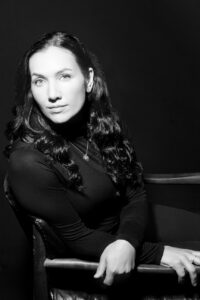Review by Jesse Lacy
After a disastrous two-year relationship, nonfiction virtuoso Melissa Febos finds herself unmoored and in need of radical change. In her fifth book, The Dry Season (Knopf, 2025), Febos challenges herself to a year without sex or dating. What may seem like a benign undertaking to some is no small thing to this writer whose life has been punctuated by a string of failed romances. To support herself through her newfound celibacy, Febos turns inward, reflecting on her “inventory” of constant failed relationships. Febos also reflects outward—drawing inspiration from feminists, artists, and spiritualists to form a new perspective on what it means to create and love. At its core, The Dry Season is interested in interrogating and divesting from the forces that inform misdirected desire.
Febos’s “inventory” of past lovers is marked with forces beyond herself, as she realizes her romantic and sexual urges are more complicated than mere longing and lust. On seduction, Febos notices that her need for celibacy has more to do with performance than pleasure. Febos writes: “I wanted to close the distance between that private self and the self I created in relationships” (81). The issue of performance and the created self punctuates the overarching narrative of the memoir. One small change Febos makes is going from wearing high heels to sneakers. What makes this change complicated is that Febos does not transform into the type of woman who prioritizes comfort in the way she dresses. Instead, Febos realizes she has always been this type of woman. Reaching toward desirability, Febos had robbed herself of both a small pleasure and a piece of her identity. An interior change Febos makes is a commitment to emotional honesty. Throughout her dry season, Febos encounters myriad situations where it would be easier for her to perform the easy scripts of romance embedded in our culture. By rejecting these scripts, Febos begins to cultivate a new type of comfort for herself: a kind of self-reliant pleasure born from celibacy measured in freedom, slowness, and the blisses of friendship.
But this is not a book solely about Febos’s personal transformation. These embedded beliefs—that being sexually and romantically desired are our two most important aspirations—are prolific in our patriarchal, partnership-obsessed culture. It is no small wonder that many people are selfish in love, that many people must confront “the pain of being ordinarily terrible” or remain unmoored, dominated by desires that do not even originate with the individual in mind (226). Febos is able to interrogate these emotional complexities with empathy for herself and her lovers, giving a new and essential perspective on sex and love.
To reconcile with these outside forces, Febos brings together a “chorus of chosen teachers” like the Beguines and Virginia Woolf (263). These teachers are women who—in some way or another—found ways to center their art, ambitions, and love in ways that challenged their world at the time. The Beguines center devotion and service in isolation from the demands made of medieval women. Woolf centers her routine and art. There is freedom in keeping oneself for oneself, Febos argues, and this freedom brings about new fullness fueled by self-determination and artistic pursuit.
While not a call to action in the traditional sense, the work done in The Dry Season commands an examination of one’s own relationship with desire, freedom, and love. After all, “The nature of feminist work is to keep realizing we are not free, until we are”, Febos writes (223). A fresh and necessary piece of feminist writing, The Dry Season is a verdant, invigorating read from a generation-defining voice in nonfiction.
